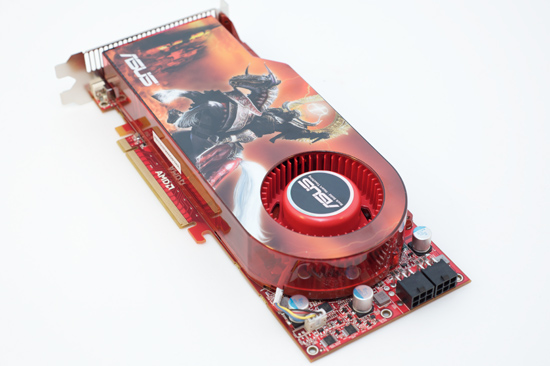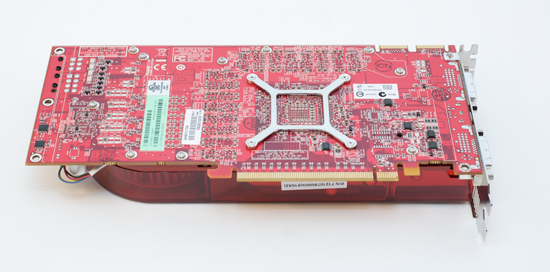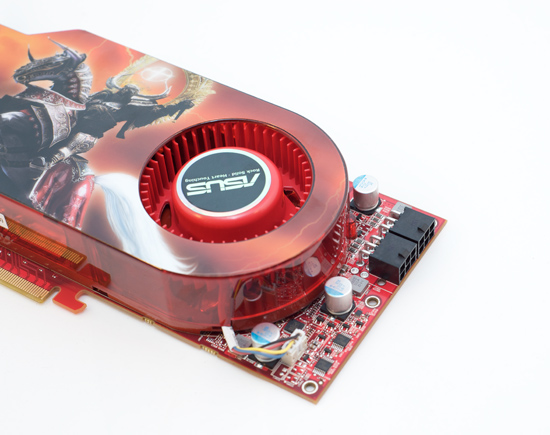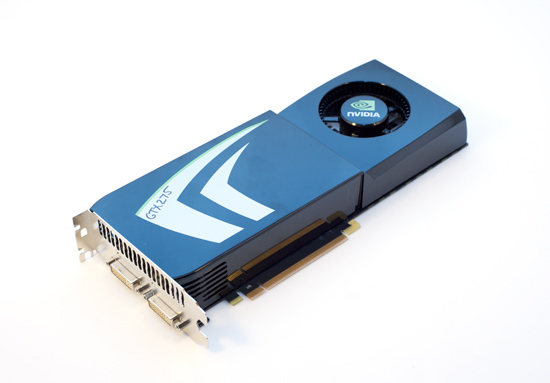ATI Radeon HD 4890 vs. NVIDIA GeForce GTX 275
by Anand Lal Shimpi & Derek Wilson on April 2, 2009 12:00 AM EST- Posted in
- GPUs
The Cards and The Test
In the AMD department, we received two cards. One was an overclocked part from HIS and the other was a stock clocked part from ASUS. Guess which one AMD sent us for the review. No, it's no problem, we're used to it. This is what happens when we get cards from NVIDIA all the time. They argue and argue for the inclusion of overclocked numbers in GPU reviews when it's their GPU we're looking at. Of course when the tables are turned so are the opinions. We sincerely appreciate ASUS sending us this card and we used it for our tests in this article. The original intent of trying to get a hold of two cards was to run CrossFire numbers, but we only have one GTX 275 and we would prefer to wait until we can compare the two to get into that angle.



The ASUS card also includes a utility called Voltage Tweaker that allows gamers to increase some voltages on their hardware to help improve overclocking. We didn't have the chance to play with the feature ourselves, but more control is always a nice feature to have.

For the Radeon HD 4890 our hardware specs are pretty simple. Take a 4870 1GB and overclock it. Crank the core up 100 MHz to 850 MHz and the memory clock up 75 MHz to 975 MHz. That's the Radeon HD 4890 in a nutshell. However, to reach these clock levels, AMD revised the core by adding decoupling capacitors, new timing algorithms, and altered the ASIC power distribution for enhanced operation. These slight changes increased the transistor count from 956M to 959M. Otherwise, the core features/specifications (texture units, ROPs, z/stencil) remain the same as the HD4850/HD4870 series.
Most vendors will also be selling overclocked variants that run the core at 900 MHz. AMD would like to treat these overclocked parts like they are a separate entity altogether. But we will continue to treat these parts as enhancements of the stock version whether they come from NVIDIA or AMD. In our eyes, the difference between, say, an XFX GTX 275 and an XFX GTX 275 XXX is XFX's call; the latter is their part enhancing the stock version. We aren't going to look at the XFX 4890 and the XFX 4890 XXX any differently. In doing reviews of vendor's cards, we'll consider overclocked performance closely, but for a GPU launch, we will be focusing on the baseline version of the card.
On the NVIDIA side, we received a reference version of the GTX 275. It looks similar to the design of the other GT200 based hardware.

Under the hood here is the same setup as half of a GTX 295 but with higher clock speeds. That means that the GTX 275 has the memory amount and bandwidth of the GTX 260 (448-bit wide bus), but the shader count of the GTX 280 (240 SPs). On top of that, the GTX 275 posts clock speeds closer to the GTX 285 than the GTX 280. Core clock is up 31 MHz from a GTX 280 to 633 MHz, shader clock is up 108 MHz to 1404 MHz, and memory clock is also up 108 MHz to 2322. Which means that in shader limited cases we should see performance closer to the GTX 285 and in bandwicth limited cases we'll still be faster than the GTX 216 because of the clock speed boost across the board.
Rather than just an overclock of a pre-existing card, this is a blending of two configurations combined with an overclock from the two configurations from which it was born. And sure, it's also half a GTX 295, and that is convenient for NVIDIA. It's not just that it's different, it's that this setup should have a lot to offer especially in games that aren't bandwidth limited.
That wraps it up for the cards we're focusing on today. Here's our test system, which is the same as for our GTS 250 article except for the addition of a couple drivers.
The Test
| Test Setup | |
| CPU | Intel Core i7-965 3.2GHz |
| Motherboard | ASUS Rampage II Extreme X58 |
| Video Cards | ATI Radeon HD 4890 ATI Radeon HD 4870 1GB ATI Radeon HD 4870 512MB ATI Radeon HD 4850 NVIDIA GeForce GTX 285 NVIDIA GeForce GTX 280 NVIDIA GeForce GTX 275 NVIDIA GeForce GTX 260 core 216 |
| Video Drivers | Catalyst 8.12 hotfix, 9.4 Beta for HD 4890 ForceWare 185.65 |
| Hard Drive | Intel X25-M 80GB SSD |
| RAM | 6 x 1GB DDR3-1066 7-7-7-20 |
| Operating System | Windows Vista Ultimate 64-bit SP1 |
| PSU | PC Power & Cooling Turbo Cool 1200W |










294 Comments
View All Comments
SiliconDoc - Monday, April 6, 2009 - link
Oh great, a whole other sku to lose another billion a year with. Wonderful. Any word on the new costs of the bigger cpu and expensive capacitors and vrm upgrades ?Ahh, nevermind, heck, this ain't a green greedy monster card, screw it if they lose their shirts making it - I mean there's no fantasy satisfaction there.
Get back to me on the nvidia costs - so I can really dream about them losing money.
itbj2 - Thursday, April 2, 2009 - link
I am not sure about you guys but NVIDIA has problems with their drivers as well. I have a 9400GT and a 8800 GTS in my machine and the new drivers can't make the two work well enough for my computer to come out of hibernation with out Windows XP crashing every so often. This use to work just fine before I upgraded the drivers to the latest version.FishTankX - Thursday, April 2, 2009 - link
For anyone who REALLY wants temp data..Firingsquad 4890/GTX275 review
http://www.firingsquad.com/hardware/ati_radeon_489...">http://www.firingsquad.com/hardware/ati...4890_nvi...
Idle
GTX 260 216 (45C)
GTX 285 (46C)
GTX 275 (47C)
4890 1GB (51C)
4870 (60C)
Load
4890 1GB (64C)
GTX 260 216 (64C)
GTX 275 (68C)
GTX 285 (70C)
4870 1GB (80C)
Power consumption
(Total system power)
Idle
GTX 275 (143W)
4890 (172W)
Load
4890 (276W)
GTX 275 (279W)
There, now you can can it! :D
SiliconDoc - Monday, April 6, 2009 - link
There it is again, 30 watts less idle for nvidia, and only 3 watts more in 3d. NVIDIA WINS - that's why they left it out - they just couldn't HANDLE it....So, if you're 3d gaming 91% of the time, and only 2d surfing 9% of the time, the ati card comes in at equal power useage...
Otherwise, it LOSES - again.
I doubt the red raging reviewers can even say it. Oh well, thanks for posting numbers.
7Enigma - Thursday, April 2, 2009 - link
Can anyone confirm whether or not the heatsink/fan has been altered between the 4870 and the 4890? I'm interested to know if the decreased temps of the higher clocked 4890 are due in part to a better cooling mechanism, or strictly from a respin/binning.Warren21 - Thursday, April 2, 2009 - link
Yes, the cooler has been slightly revised. I believe it's a combination of both. I'll admit I'm a bit disappointed AT didn't explore the differences between the HD 4870 and the 4890 more in-depth.Comparisson:
http://www.hardwarecanucks.com/forum/hardware-canu...">http://www.hardwarecanucks.com/forum/ha...phire-ra...
bill3 - Thursday, April 2, 2009 - link
"It looks like NVIDIA might be the marginal leader at this new price point of $250." you wroteBut looking at your own benches..
Since you run 3 resolutions of your benches, lets reasonably declare that the card that can win 2 or more of them "wins" that game. In that case 4890 wins over 275 in: COD WaW, Warhead, Fallout 3, Far Cry 2, GRID, and Left 4 Dead. 275 wins over 4890 in Age of Conan. Either with AA or without the results stay the same.
The only way I think you can contend 275 has an edge is if you place a premium on the 2560X1600 results, where it seems to edge out the 4890 more often. However, it's often at unplayable framerates. Further I dont see a reason to place undue importance on the 2560X benches, the majority of people still game on 1680X1050 monitors, and as you yourself noted, Nvidia released a new driver that trades off performance at low res for high res, which I think is arguably neither here nor their, not a clear advantage at all.
Even at 2560 (using the AA bar graphs because its often difficult to spot the winner at 2560 on the line graphs), where the 275 wins 5 and loses 2, the margins are often so ridiculously close it essentially a tie. 275 takes AOC, COD WaW, and L4D by a reasonable margin at the highest res, while the 4890 wins Fallout3 and GRID comfortably. Warhead and Far Cry 2 are within .7 FPS although nominally wins for 275. Thats a difference of all of 3-2 in materially relevant wins, or exactly 1 game. But keep in mind again that 4890 is fairly clearly winning the lower reses more often, and to me it's wrong to state 275 has the edge.
SiliconDoc - Monday, April 6, 2009 - link
The funny thing is, if you're in those games and constantly looking at your 5-10 fps difference at 50-60-100-200 fps - there's definitely something wrong with you.I find reviews that show LOWEST framerate during game when it's a very high resolution and a demanding game useful - usually more useful when the playable rate is hovering around 30 or below 50 (and dips a ways below 30.
Otherwise, you'd have to be an IDIOT to base your decision on the very often, way over playable framerates in the near equally matched cards. WE HAVE A LOT OF IDIOTS HERE.
Then comes the next conclusion, or the follow on. Since framerates are at playable, and are within 10% at the top end, the things that really matter are : game drivers / stability , profiles , clarity, added features, added box contents (a free game one wants perhaps).
Almost ALWAYS, Nvidia wins that - with the very things this site continues to claim simply do not matter, and should not matter - to ANYONE they claim - in effect.
I think it's one big fat lie, and they most certainly SHOULD know it.
Note now, that NVidia - having released their, according to this site, high resolution driver tweak for 2560xX , wins at that resolution, the review calmly states it does'nt matter much, most people don't play at that resolution - and recommend ati now instead.
Whereas just prior, for MONTHS on end, when ati won only the top resolution, and NVidia took the others, this same site could not stop ranting and raving that ATI won it all and was the only buy that made sense.
It's REALLY SICK.
I pointed out their 30" monitor for ATI bias months ago, and they continued with it - but now they agree with me - when ATI loses at that rezz... LOL
Yeah, they're schesiters. Ain't no doubt about it.
Others notice as well - and are saying things now.
I see Jarred is their damage control agent.
JonnyDough - Thursday, April 2, 2009 - link
Why not just use RivaTuner or ATI Tool to underclock OC'd cards?Jamahl - Thursday, April 2, 2009 - link
How can the conclusion be that the 275 is the leader at the price point? The benchmarks are clearly in favour of the 4890 apart from the extreme end 2560x1600.